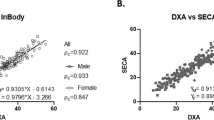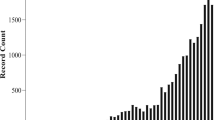Abstract
Background/objectives:
To determine the effect of a meal on impedance and percent body fat (%BF) determined using contact-electrode bioelectrical impedance analysis (BIA) technology.
Subjects/methods:
Forty-three adults (23 women and 20 men) volunteered to participate in this study (age=20.5±1.1 years; body mass index=24.1±3.8 kg/m2). Body composition was assessed using three BIA analyzers: leg-to-leg (LBIA), segmental (SBIA) and multi-frequency (MFBIA), on two separate occasions. After a baseline measurement, subjects consumed a meal or received nothing, which served as the control (CON). Subjects were reassessed 20, 40 and 60 min following (POST) the baseline measure in each condition.
Results:
Twenty minutes after eating (3847±900 kJ), body mass (LBIA=0.8 kg, SBIA=0.8 kg, MFBIA=0.7 kg, P<0.05), impedance (LBIA=6.0 Ω, SBIA=17.9 Ω, MFBIA=27.1 Ω, P<0.05) and %BF (LBIA=0.9%, SBIA=1.7%, MFBIA=0.8%, P<0.05) increased significantly and remained elevated at 60 min POST. During the CON trial, a consistent body mass reduction (60–80 g) and impedance increase (4–9 Ω) was observed over time resulting in a small increase in %BF (0.3–0.7%) 60 min POST (P<0.05).
Conclusions:
Twenty minutes after eating, %BF increased due to elevations in impedance and body mass. As such, when precision is critical, we recommend adhering to the pretest fasting guidelines to avoid meal-induced alterations in %BF estimates. In addition, use of a consistent testing schedule may minimize normal %BF variation over time.
This is a preview of subscription content, access via your institution
Access options
Subscribe to this journal
Receive 12 print issues and online access
$259.00 per year
only $21.58 per issue
Buy this article
- Purchase on Springer Link
- Instant access to full article PDF
Prices may be subject to local taxes which are calculated during checkout


Similar content being viewed by others
References
National Institutes of Health Technology Assessment Conference (NIHTAC) (1996). Bioelectrial impedance analysis in body composition measurement. Am J Clin Nutr 1996; 64: 524–532.
Nunez C, Gallagher D, Visser M, Pi-Sunyer FX, Wang Z, Heymsfield SB . Bioimpedance analysis: evaluation of leg-to-leg system based on pressure contact foot-pad electrodes. Med Sci Sports Exerc 1997; 29: 524–531.
Lukaski HC . Assessing regional muscle mass with segmental measurements of bioelectrical impedance in obese women during weight loss. Ann NY Acad Sci 2000; 904: 154–158.
Heyward VH, Wagner DR . Applied Body Composition Assessment, 2nd edn. Human Kinetics: Champaign, IL, USA, 2004, pp 87–98.
Roche AF, Heymsfield SB, Lohman TG . Human body composition. Human Kinetics: Champaign, IL, USA, 1996, pp 79–108.
Deurenberg P, Weststrate JA, Paymans I, van der Kooy K . Factors affecting bioelectrical impedance measurement in humans. Eur J Clin Nutr 1988; 42: 1017–1022.
Gomez T, Mole PA, Collins A . Dilution of body fluid electrolytes affects bioelectrical impedance measurements. Sports Med Training Rehab 1993; 4: 291–298.
Kushner RF, Gudivaka R, Schoeller DA . Clinical characteristics influencing bioelectrical impedance analysis measurements. Am J Clin Nutr 1996; 64: 423–427.
Dixon CB, Lovallo SJ, Andreacci JL, Goss FL . The effect of acute fluid consumption on measures of impedance and percent body fat using leg-to-leg bioelectrical impedance analysis. Eur J Clin Nutr 2006; 60: 142–146.
Dixon CB, Ramos L, Fitzgerald E, Reppert D, Andreacci JL . The effect of acute fluid consumption on measures of impedance and percent body fat estimated using segmental bioelectrical impedance analysis. Eur J Clin Nutr 2009; 63: 1115–1122.
Dixon CB, Fitzgerald E, Makuta L, Andreacci JL . The effect of acute fluid consumption on measures of impedance and percent body fat estimated using leg-to-leg and segmental bioelectrical impedance analysis in children. Int J Body Comp Res 2012; 10: 21–28.
Gallagher M, Walker KZ, O’Dea K . The influence of a breakfast meal on the assessment of body composition using bioelectrical impedance. Eur J Clin Nutr 1998; 52: 94–97.
Vilaça KH, Ferriolli E, Lima NK, Paula FJ, Moriquti JC . Effect of fluid and food intake on the body composition evaluation of elderly persons. J Nutr Health Aging 2009; 13: 183–186.
Costill DL, Saltin B . Factors limiting gastric emptying during rest and exercise. J Appl Physiol 1974; 37: 679–683.
Pietrobelli A, Rubiano F, St-Onge M-P, Heymsfield SB . New bioimpedance analysis system: improved phenotyping with whole-body analysis. Eur J Clin Nutr 2004; 58: 1479–1484.
Bland JM, Altman DG . Statistical methods for assessing agreement between two methods of clinical measurement. Lancet 1986; 1: 307–310.
Gomez T, Mole PA, Collins A . Dilution of body fluid electrolytes affects bioelectrical impedance measurements. Sports Med Train Rehabil 1993; 4: 291–298.
Slinde F, Bark A, Jansson J, Rossander-Hulthen L . Bioelectrical impedance variation in healthy subjects during 12 h in the supine position. Clin Nutr 2003; 22: 153–157.
Oshima Y, Shiga T . Within-day variability of whole-body and segmental bioelectrical impedance in a standing position. Eur J Clin Nutr 2006; 60: 938–941.
Acknowledgements
We gratefully acknowledge all subjects for their participation in this investigation. This investigation was supported by a Small Campus Research Grant from Lock Haven University.
Author information
Authors and Affiliations
Corresponding author
Ethics declarations
Competing interests
The authors declare no conflict of interest.
Additional information
Contributors: CBD and BM were responsible for study design, data collection and analysis, and writing of the manuscript. JLA was responsible for statistical analysis and assisted in writing of the manuscript.
Rights and permissions
About this article
Cite this article
Dixon, C., Masteller, B. & Andreacci, J. The effect of a meal on measures of impedance and percent body fat estimated using contact-electrode bioelectrical impedance technology. Eur J Clin Nutr 67, 950–955 (2013). https://doi.org/10.1038/ejcn.2013.118
Received:
Revised:
Accepted:
Published:
Issue Date:
DOI: https://doi.org/10.1038/ejcn.2013.118
Keywords
This article is cited by
-
Effect of weight satisfaction on adolescent facial and dental satisfaction
European Archives of Paediatric Dentistry (2024)
-
No differences in the body fat after violating core bioelectrical impedance measurement assumptions
BMC Public Health (2021)



